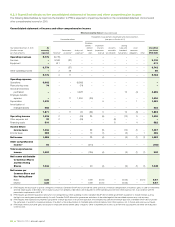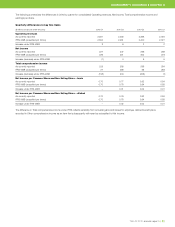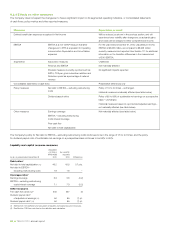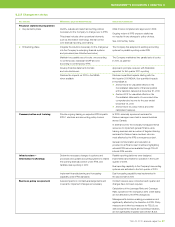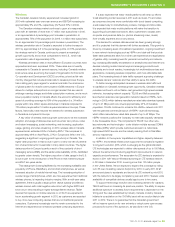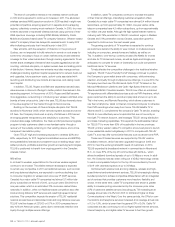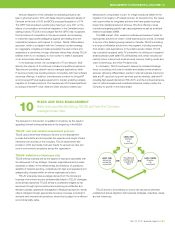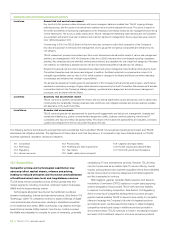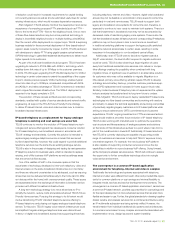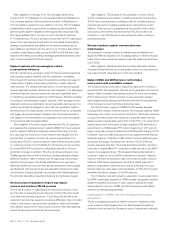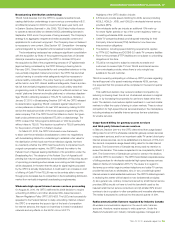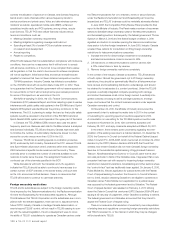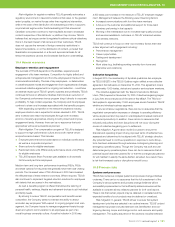Telus 2010 Annual Report Download - page 98
Download and view the complete annual report
Please find page 98 of the 2010 Telus annual report below. You can navigate through the pages in the report by either clicking on the pages listed below, or by using the keyword search tool below to find specific information within the annual report.94 . TELUS 2010 annual report
the use of licensed and/or unlicensed spectrum to deliver higher-speed
data services. In addition satellite operators such as Barrett Xplore have
announced that they are augmenting their existing HSIA capabilities
with the launch of high-throughput satellites, targeting households in
rural and remote locations claiming to offer speeds of up to 10 Mbps.
Risk mitigation in wireless markets: The Company improved its
competitive position with the launch of its HSPA+ wireless network in
November 2009. The network offers manufacturer-rated data down-
load speeds of up to 21 Mbps and covers approximately 97% of
Canada’s population, including network sharing agreements with Bell
Canada and SaskTel. In 2010 and 2011, the Company is deploying
HSPA+ dual-cell technology, which is expected to increase manufacturer-
rated maximum data download speeds to up to 42 Mbps when
commercialized.
HSPA+ technology enables TELUS to provide an expanded selection
of mobile devices and capability to roam in more than 200 countries.
Prior to November 2009, Rogers Communications Inc., as the only
global system for mobile communication (GSM) and HSPA competitor
in Canada, enjoyed advantages in handset selection, earlier availability
of certain devices, lower handset costs and access to international
in-roaming revenue.
The Company introduced a variety of initiatives in 2010 to bring
greater transparency and simplicity to customers, such as data notifica-
tions, the new Clear and Simple Device Upgrade program, and a more
transparent cancellation policy for those who have activated or renewed
their contract after November 20, 2010. (See Section 2.2 Strategic
imperatives – Providing integrated solutions that differentiate TELUS from
its competitors.) In addition, to compete more effectively in serving a
variety of customer segments, TELUS also offers a basic service brand
called Koodo Mobile first launched in March 2008.
TELUS intends to continue the marketing and distribution of innovative
and differentiated wireless services; investing in its extensive network;
evolving technologies when deemed prudent; and acquiring spectrum,
as appropriate, to facilitate service development and profitable expansion
of the Company’s subscriber base.
10.2 Technology
Technology is a key enabler for TELUS and its customers, however,
technology evolution brings risks, uncertainties and opportunities.
TELUS is vigorous in maintaining its short-term and long-term technology
strategy to optimize the Company’s selection and timely use of tech-
nology, while minimizing the associated costs, risks and uncertainties.
The following identifies the main technology risks and uncertainties
and how TELUS is proactively addressing them.
Evolving wired broadband access technology standards may
outpace projected access infrastructure investment lifetimes
The technology standards for broadband access over copper loops
to customer premises are evolving rapidly, enabling higher broadband
access speeds. The evolution is fuelled by user appetite for faster con-
nectivity, the threat of increasing competitor capabilities and offerings,
and the desire of service providers like TELUS to offer new services,
such as IP TV, that require greater bandwidth. In general, the evolution
to higher broadband access speeds is achieved by deploying fibre
further out from the central office, thus shortening the copper loop
portion of the access network and using faster modem technologies
on the shortened copper loop. However, new access technologies
are evolving faster than the traditional investment cycle for access infra-
structure. The introduction of these new technologies and the pace
enabled the Company’s June 2010 launch of the Optik brand, featuring
a suite of advanced TV and high-speed Internet services (see Section 2.2
Strategic imperatives), and drove an 85% expansion in TELUS’ TV
subscriber base in 2010.
Increasing vertical integration by competitors into broadcast
content ownership
While TELUS is not currently seeking to be a broadcast content owner,
several competitors have acquired broadcast content assets. This
includes Shaw Communications’ 2010 acquisition of Canwest Global
and BCE’s pending acquisition of the programming services of
CTVglobemedia, while Rogers Communications and Quebecor already
own content assets. There is a risk that vertical integration could result
in content being withheld from TELUS, or being made available at
inflated prices.
Risk mitigation: TELUS’ strategy is to aggregate, integrate and
make accessible content and applications for customers’ enjoyment.
The Company does not believe it is necessary to own content to
make it accessible to customers on an economically attractive basis
and it is not clear that any positive synergies of ownership for carriers
outweigh negative synergies of limiting audiences through exclusive
arrangements and impacts on other supplier relationships. This inherent
conflict may limit preferential self-dealing by vertically integrated competi-
tors, however, TELUS believes that regulatory safeguards are necessary.
The CRTC has initiated a proceeding to discuss issues related to vertical
integration. (See Section 10.3 Regulatory – Broadcasting distribution
undertakings and Risk mitigation for regulatory matters.)
Wireless markets
Wireless competitive intensity is expected to increase
The AWS spectrum auction in 2008 resulted in eight new potential
competitors acquiring spectrum in separate and overlapping regions,
collectively covering most markets in Canada. By the end of 2010,
four new entrants had launched services using portions of their AWS
spectrum coverage and are expected to expand their roll-outs in
2011. Shaw Communications has announced that it expects to launch
services in early 2012 (see key assumption discussion in Section 1.4).
New entrants, with the exception of Quebecor (Videotron) in the province
of Quebec, are not expected to build networks in remote and rural
areas for some time, choosing instead to focus on urban markets and
provide extended coverage for their urban-based subscribers through
roaming agreements. To win market share, strategies of entrants
have included price discounting relative to incumbents, unlimited rate
plans or zone-based pricing, and increased competition at points of
distribution. Existing competitors have also become more aggressive,
re-launching or introducing new brands.
TELUS anticipates continued pressure on average revenue per
subscriber unit (ARPU), cost of acquisition (COA) and cost of retention
(COR) as competitors increase subsidies for handsets (particularly for
generally more expensive smartphones), lower prices for airtime and
wireless data, and offer other incentives to attract new customers.
TELUS believes it has positioned itself well to respond to the arrival of
new entrants and increased competitive intensity from incumbents,
but there can be no assurance that the Company’s preparations and
responses will be as successful as planned.
Competition from adjunct wireless technologies may increase
While adjunct wireless technologies, like fixed WiMAX and Wi-Fi (wireless
fidelity), are continuing to develop, their associated economic viability
remains unproven. Regardless, increased competition is expected through


